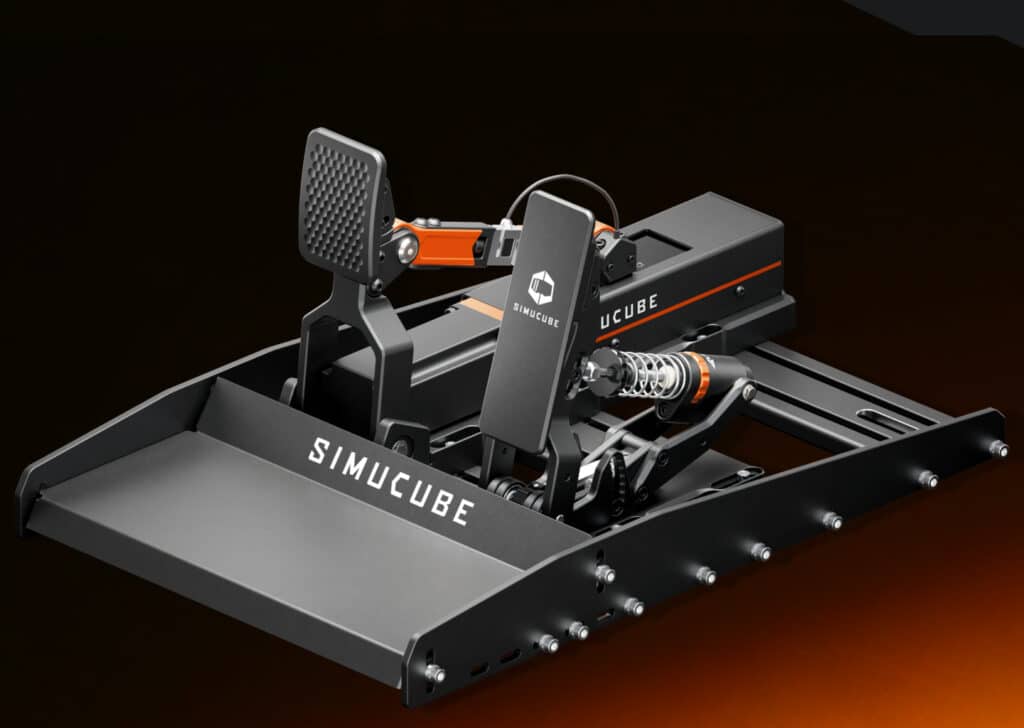Pedal technologies in sim racing
Sim racing has come a long way from arcade-style gameplay. Racing simulator manufacturers are focused on creating the most realistic experience possible, that closely matches how a real car feels. This allows motorsport professionals to practice at a fraction of the cost of real-world track racing.
Competitive sim racers choose technology that provides consistent and accurate feedback, helping them build muscle memory and improve lap times. Enthusiasts also want their sim racing gear to deliver an authentic, realistic feel.
But what powers this level of realism? Let’s explore pedal technologies in sim racing and why they’ve been chosen to help you get the most out of your racing simulator.
What types of pedals are available for sim racing?
Sim racing pedals generally rely on one of four main sensor types: potentiometer, Hall, hydraulic pressure, or load cell. Below is a summary of these pedal technologies.
Pedal Technologies in Sim Racing
| Pedal technology | Type of sensor | Measurement |
| Potentiometer | Rotary | Position of pedal, how far the pedal moves |
| Hall | Magnetic | Position of pedal, how far the pedal moves |
| Load cell | Load cell | Force (weight) applied to a pedal |
| Hydraulic | Hydraulic pressure | Fluid pressure, then more pressure applied to a pedal then more resistance it gives – progressive resistance feeling |
Potentiometer pedals use a rotary sensor to track how far the pedal is pushed. As the pedal moves, the sensor detects changes in resistance and translates that into input. This method is simple and cost-effective, which makes it common in entry-level setups. However, because it measures position rather than pressure, it offers limited realism and tends to wear out over time due to mechanical friction.
A Hall sensor is a magnetic sensor that measures the pedal’s position, similar to how a potentiometer works. However, unlike a potentiometer, a Hall sensor operates without physical contact, eliminating wear and tear. Hall sensors are commonly used in throttle and clutch pedals in real racing cars for position sensing. They are also popular in more advanced sim racing setups. As in the real world, in sim racing, Hall sensors are better suited for throttle and clutch pedals rather than the brake, as they measure the pedal’s position, how far it moves, rather than the force applied.
Pedals with hydraulic pressure take a different approach. They use fluid, typically brake fluid or oil, within a master cylinder to simulate the pressure and feedback of a real car’s braking system. As pressure builds in the fluid chamber when you press the pedal, a sensor measures that pressure and converts it into a signal. This method delivers a realistic, progressive resistance that closely mirrors real-world braking. However, such hydraulic systems are more complex, require regular maintenance, and can sometimes suffer from fluid leaks or performance degradation over time. They also tend to be more expensive, often reserved for advanced or professional users.
Load cell pedals work by measuring the actual force applied to the pedal, rather than position or hydraulic pressure. This method is highly accurate, consistent, and durable, with no moving parts that wear out. Load cells require very little maintenance and are a preferred choice for serious sim racers aiming for long-term performance and training consistency. All pedal types are shown in the table below for visual comparison.
At Simucube, the load cells are not placed directly under the foot. Instead, Simucube optimizes their placement for accuracy, measuring forces digitally across multiple dimensions through software. In addition, in Simucube ActivePedals traditional mechanical systems such as springs and fluids are replaced with a motor-powered setup. A motor-driven feedback system is combined with software-defined pedal feel. This allows adjustment of pedal force and behaviour through software rather than physical components, extending pedal lifespan.
Sim racing pedals comparison
| Feature | Potentiometer, Hall
(pedal’s position) |
Load Cell
(applied force) |
Hydraulic
(applied pressure) |
| Realism Level | Basic | More realistic feel, especially for competitive sim racing | Progressive resistance and feedback as in a real car |
| Price Range | Low | Mid | High
|
| Durability | Low to Medium
(Wears out over time – friction-based parts) |
High
|
High
(if maintained) |
| Maintenance | Low,
easy to replace or repair |
Low | High
maintenance (can leak or require bleeding) |
| Accuracy | Low
|
High | High |
| Best fit for | Casual Racers / Beginners
Better suits to throttle and clutch rather than brake pedal |
Competitive / League Racers
Braking becomes more consistent, which improves lap times and confidence |
Real-World Racers / Hardcore Sims
The most realistic feel to match real race cars braking |
If you want to learn more about high-end sim racing pedals, check out our blogs:




